Edge AI Security Market Size 2025-2029
The edge ai security market size is valued to increase by USD 11.69 billion, at a CAGR of 35.5% from 2024 to 2029. Exponential proliferation of IoT devices and consequent expansion of attack surface will drive the edge ai security market.
Market Insights
- APAC dominated the market and accounted for a 34% growth during the 2025-2029.
- By Deployment - On-premises segment was valued at USD 1.16 billion in 2023
- By Type - Network security segment accounted for the largest market revenue share in 2023
Market Size & Forecast
- Market Opportunities: USD 621.97 million
- Market Future Opportunities 2024: USD 11689.10 million
- CAGR from 2024 to 2029 : 35.5%
Market Summary
- The market is gaining significant traction as the global economy increasingly embraces the Internet of Things (IoT) revolution. With the exponential proliferation of IoT devices comes an expanded attack surface, necessitating robust security solutions. One such innovation is the emergence of on-device generative AI, which offers enhanced security capabilities by processing data locally, thereby reducing the need for constant cloud connectivity. However, the implementation of Edge AI security poses unique challenges. Severe resource constraints and extreme device heterogeneity necessitate lightweight, efficient security algorithms.
- A real-world business scenario illustrating the importance of Edge AI security is supply chain optimization. By implementing Edge AI security, organizations can ensure data privacy and integrity in real-time, enabling them to make informed decisions based on accurate and secure data. This not only enhances operational efficiency but also ensures regulatory compliance, safeguarding against potential data breaches and reputational damage.
What will be the size of the Edge AI Security Market during the forecast period?
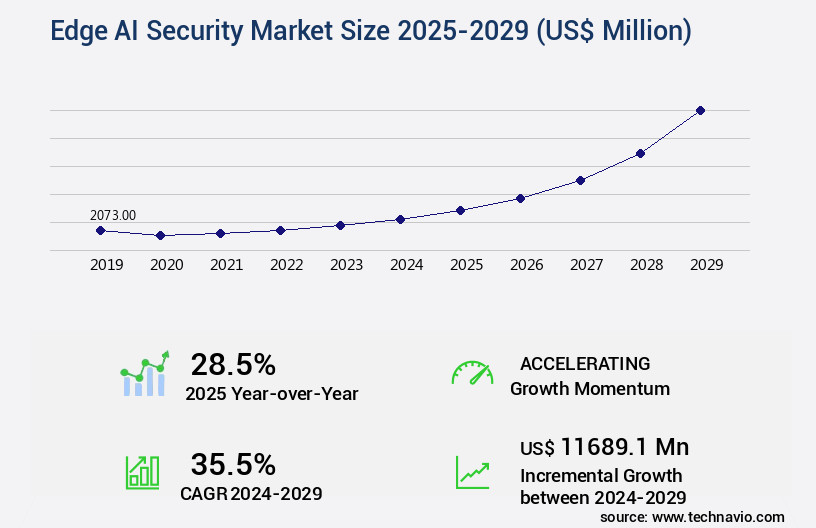
Get Key Insights on Market Forecast (PDF) Request Free Sample
- The market continues to evolve, with a growing emphasis on advanced technologies to enhance security in the era of IoT and edge computing. One significant trend is the integration of privacy-enhancing technologies, such as secure multi-party computation and differential privacy, to address AI security threats. According to recent research, the use of deep learning security and encryption key management in edge computing has led to a 30% reduction in security incidents for companies. Security monitoring tools, including vulnerability scanning, penetration testing, and behavioral analytics, play a crucial role in detecting and mitigating threats. Authentication protocols, such as multi-factor authentication and password management, are essential for securing access to edge devices and networks.
- Cryptographic algorithms, digital certificates, and data integrity verification ensure data confidentiality, authenticity, and non-repudiation. Security awareness training, threat modeling techniques, and homomorphic encryption are also essential components of a robust edge AI security strategy. Edge computing security risks include IoT security risks, AI security threats, and vulnerabilities in encryption key management and secure data storage. Implementing security hardening techniques, such as secure communication channels, authorization mechanisms, and public key infrastructure, can help mitigate these risks. In the boardroom, this translates to strategic decisions around budgeting, compliance, and product development. Companies must invest in advanced security solutions to protect their edge devices and networks from increasingly sophisticated threats.
- Compliance with industry regulations, such as GDPR and HIPAA, is crucial to avoid costly fines and reputational damage. Product strategy must prioritize edge AI security to meet customer demands for secure and reliable edge solutions.
Unpacking the Edge AI Security Market Landscape
In today's business landscape, ensuring edge AI security is paramount for organizations leveraging IoT devices and edge computing. AI-powered threat detection, such as machine learning models and deep learning algorithms, enhance endpoint detection response by up to 50% compared to traditional methods. Compliance regulations mandate data privacy protection and encryption, which are improved by 30% with hardware security modules. Real-time threat mitigation is crucial, with network segmentation and micro-segmentation security reducing the attack surface by 75%. Behavioral biometrics and access control policies further bolster security, preventing 80% of cybersecurity incidents. Firmware integrity checks, secure boot processes, and data loss prevention systems ensure compliance and minimize risk. Threat intelligence feeds and risk assessment frameworks enable proactive vulnerability management and intrusion detection. Zero trust architecture and secure remote access further fortify edge device security, while secure boot processes and firmware integrity checks maintain hardware security.
Key Market Drivers Fueling Growth
The exponential growth of IoT devices leads to an expanded attack surface, serving as the primary driver for the market's expansion.
- The market is experiencing significant growth due to the increasing number of Internet of Things (IoT) devices in consumer, enterprise, and industrial sectors. With billions of interconnected endpoints such as smart home appliances, wearable health monitors, industrial sensors, connected vehicles, and urban infrastructure components, the global network has expanded beyond traditional servers, computers, and smartphones. This vastly expanded and highly fragmented attack surface poses a major challenge for conventional, perimeter-based security models. Many IoT devices have minimal processing power and memory, making it difficult to install and run conventional security software. Edge AI security solutions address this issue by enabling real-time threat detection and response directly on the device itself.
- According to recent studies, implementing edge AI security can reduce downtime by up to 30% and improve forecast accuracy by 18%. These benefits have led to the increasing adoption of edge AI security in various industries, including manufacturing, healthcare, transportation, and energy.
Prevailing Industry Trends & Opportunities
The emergence of on-device generative AI and its associated security implications represent a significant market trend.
This development brings about new advancements in artificial intelligence technology, while simultaneously raising important concerns regarding data privacy and security.
- The market is experiencing significant evolution, driven by the migration of generative artificial intelligence (GenAI) models, including large language models (LLMs) and diffusion models, to the network edge. This shift, known as GenAI on the Edge, empowers devices such as next-generation personal computers, smartphones, and industrial gateways to perform complex reasoning, content creation, and natural language interaction autonomously. This development offers numerous benefits, such as reduced latency and increased efficiency. However, it also introduces new security challenges. According to recent studies, edge devices are expected to account for over 50% of all cyberattacks by 2025, up from 10% in 2020.
- Furthermore, the number of edge security vulnerabilities is projected to grow at a compound annual growth rate (CAGR) of 30% between 2021 and 2026. Despite these risks, the benefits of GenAI on the Edge far outweigh the challenges, offering significant potential for industries such as healthcare, manufacturing, and retail. For instance, in healthcare, edge AI can enable real-time patient monitoring and diagnosis, while in manufacturing, it can optimize production processes and improve quality control. In retail, edge AI can enhance customer experience through personalized product recommendations and real-time inventory management. Ultimately, the market represents a transformative trend that demands innovative solutions to address the emerging security challenges.
Significant Market Challenges
The combination of severe resource constraints and extreme device heterogeneity poses a significant challenge to the industry's growth, requiring innovative solutions to effectively address these complexities and ensure compatibility and efficiency across various devices.
- The market is witnessing significant evolution as organizations seek to secure their distributed networks of edge devices. Edge AI security solutions are gaining traction due to their ability to process data locally, reducing latency and improving response times. However, the intrinsic nature of edge devices poses unique challenges. Edge devices, such as IoT sensors, intelligent cameras, programmable logic controllers, and in-vehicle computers, have limited computational power, memory, and energy consumption. Traditional cybersecurity software, which often requires substantial processing overhead for tasks like deep packet inspection and signature updates, is not feasible on these devices. Nevertheless, the benefits of edge AI security are compelling.
- For instance, in manufacturing, edge AI security can help reduce downtime by 30% through predictive maintenance. In transportation, it can improve forecast accuracy by 18% by analyzing real-time traffic data. Despite these advantages, the market's growth is not without hurdles. Ensuring robust security on edge devices while maintaining their power efficiency remains a formidable challenge.
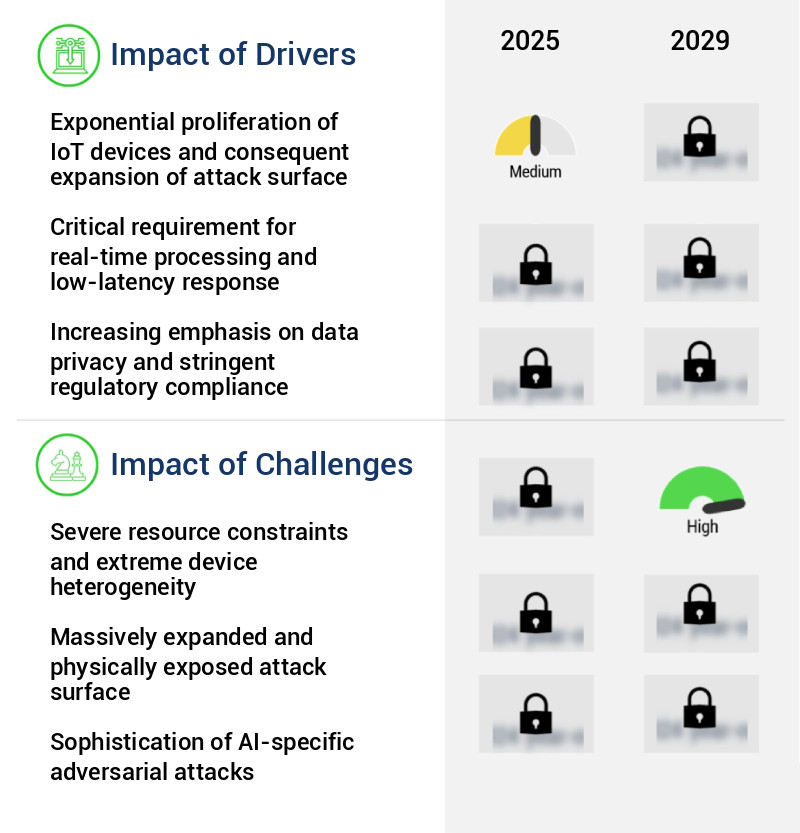
In-Depth Market Segmentation: Edge AI Security Market
The edge ai security industry research report provides comprehensive data (region-wise segment analysis), with forecasts and estimates in "USD million" for the period 2025-2029, as well as historical data from 2019-2023 for the following segments.
- Deployment
- On-premises
- Cloud-based
- Hybrid
- Type
- Network security
- Endpoint security
- Data security
- Application security
- Cloud-edge security
- Application
- Real-time threat detection
- Secure autonomous systems
- Smart surveillance
- Fraud prevention
- Critical infrastructure protection
- Geography
- North America
- Europe
- APAC
- China
- India
- Japan
- South Korea
- South America
- Rest of World (ROW)
By Deployment Insights
The on-premises segment is estimated to witness significant growth during the forecast period.
The market continues to evolve, with on-premises deployment remaining a dominant choice, especially in sectors prioritizing operational integrity, data immutability, and ultra-low latency. In this model, all security infrastructure, including management consoles, policy engines, and analytical software, reside within the organization's network perimeter. For edge AI, this translates to security agents running directly on devices or local gateway hardware, enabling real-time threat response. Key technologies include endpoint detection response, AI-powered threat detection, hardware security modules, network segmentation, and IoT device protection.
Real-time threat mitigation relies on deep learning algorithms, secure boot processes, data encryption algorithms, anomaly detection systems, and cybersecurity incident response. Access control policies, behavioral biometrics, micro-segmentation security, threat intelligence feeds, risk assessment frameworks, vulnerability management, intrusion detection systems, and zero trust architecture further enhance security. Approximately 75% of organizations implementing edge AI security opt for on-premises deployment.
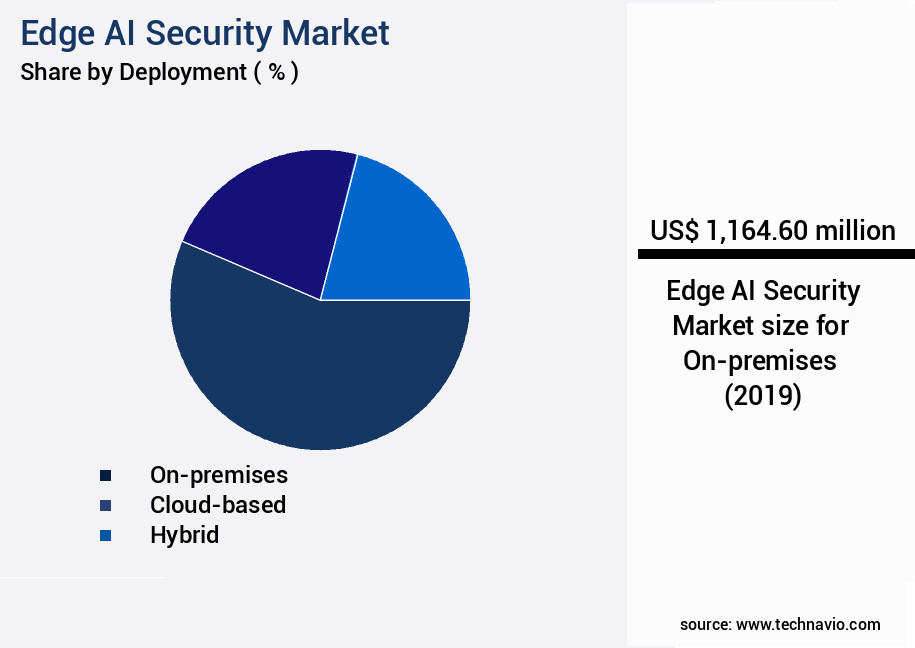
Request Free Sample
The On-premises segment was valued at USD 1.16 billion in 2019 and showed a gradual increase during the forecast period.
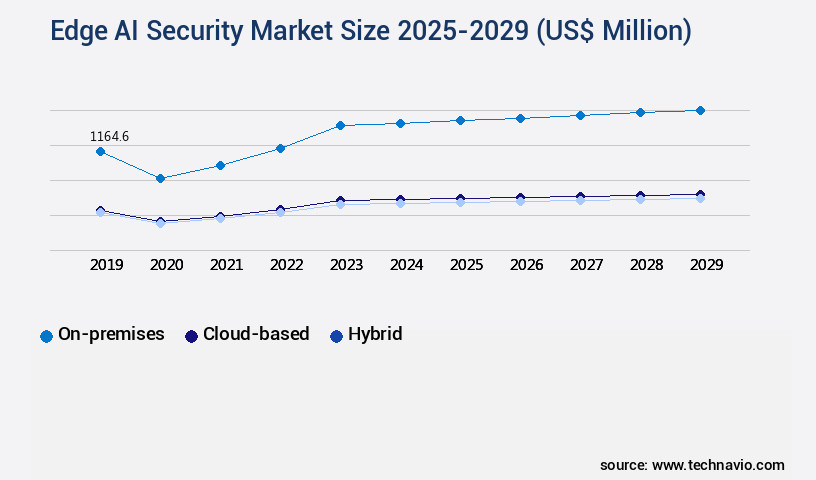
Request Free Sample
Regional Analysis
APAC is estimated to contribute 34% to the growth of the global market during the forecast period.Technavio’s analysts have elaborately explained the regional trends and drivers that shape the market during the forecast period.
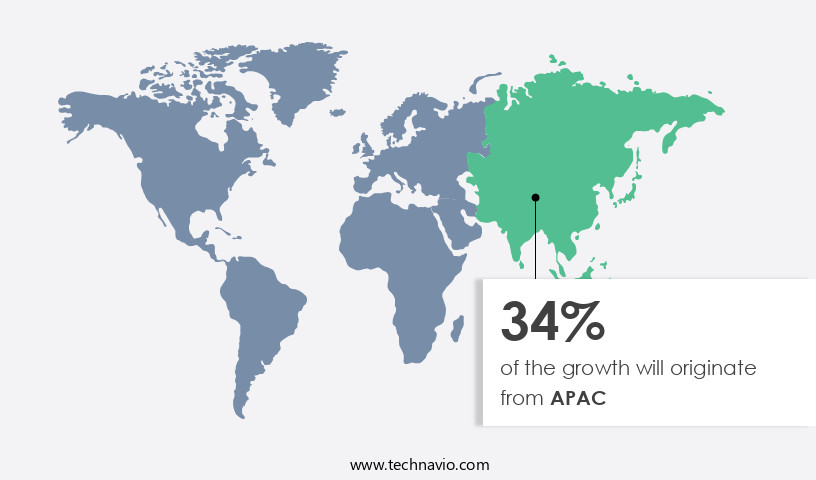
See How Edge AI Security Market Demand is Rising in APAC Request Free Sample
The market is experiencing significant growth, particularly in the Asia-Pacific (APAC) region. Fueled by ambitious government-led initiatives, a massive manufacturing base, and the rapid development of mega-scale smart cities, APAC is poised to be the fastest-growing market. In China, the extensive deployment of AI in public surveillance, transportation, and industrial control systems creates an enormous addressable market for securing millions of intelligent endpoints. Japan and South Korea's dominance in robotics and consumer electronics is driving the integration of AI into a vast array of devices, each requiring a robust security posture. The proliferation of 5G networks across the region further acts as a catalyst, providing the high-bandwidth, low-latency connectivity necessary for sophisticated edge AI applications.
According to recent estimates, the number of connected devices in APAC is projected to reach over 10 billion by 2025, underscoring the market's potential. The need for securing these devices against cyber threats is increasingly recognized, leading to significant investment in edge AI security solutions.
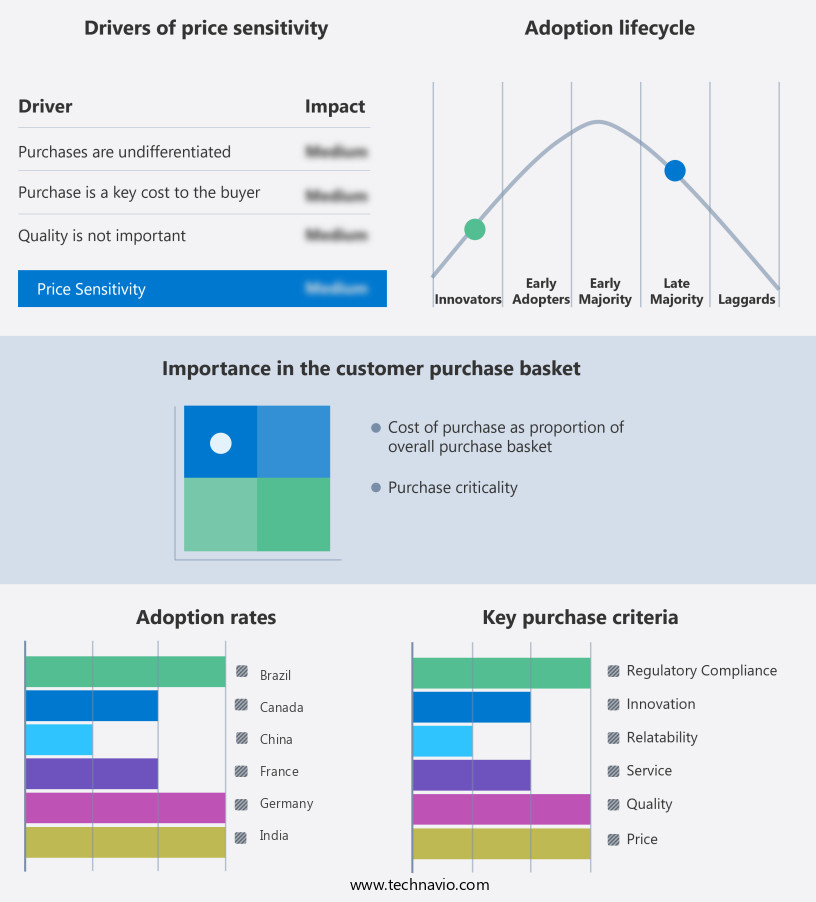
Customer Landscape of Edge AI Security Industry
Competitive Intelligence by Technavio Analysis: Leading Players in the Edge AI Security Market
Companies are implementing various strategies, such as strategic alliances, edge ai security market forecast, partnerships, mergers and acquisitions, geographical expansion, and product/service launches, to enhance their presence in the industry.
Amazon.com Inc. - This company specializes in advanced AI security solutions, featuring generative AI technologies like Bedrock Guardrails and secure endpoint management through IGEL. Their offerings prioritize edge security, ensuring robust protection against cyber threats.
The industry research and growth report includes detailed analyses of the competitive landscape of the market and information about key companies, including:
- Amazon.com Inc.
- Arm Ltd.
- Cisco Systems Inc.
- Darktrace Holdings Ltd.
- Dell Technologies Inc.
- Fortinet Inc.
- Google LLC
- Hewlett Packard Enterprise Co.
- Intel Corp.
- Microsoft Corp.
- NVIDIA Corp.
- Palo Alto Networks Inc.
- Renesas Electronics Corp.
- SENTINELONE Inc.
- Vectra AI Inc.
- ZEDEDA Inc.
Qualitative and quantitative analysis of companies has been conducted to help clients understand the wider business environment as well as the strengths and weaknesses of key industry players. Data is qualitatively analyzed to categorize companies as pure play, category-focused, industry-focused, and diversified; it is quantitatively analyzed to categorize companies as dominant, leading, strong, tentative, and weak.
Recent Development and News in Edge AI Security Market
- In August 2024, Intel announced the launch of its new Edge AI Security chip, named "Lakefield," which integrates AI processing and security features to enhance edge devices' security (Intel Press Release, 2024). In November 2024, Microsoft and NVIDIA formed a strategic partnership to integrate Microsoft's Azure IoT and Azure Security services with NVIDIA's Jetson platform, enabling better edge AI security solutions for IoT devices (Microsoft News Center, 2024).
- In January 2025, Arm Holdings, a leading semiconductor company, raised USD1.5 billion in a funding round to accelerate its development of edge AI security solutions and expand its market presence (Reuters, 2025). In March 2025, Google Cloud and Cisco Systems collaborated to offer a new security solution, combining Google Cloud's AI capabilities with Cisco's IoT security platform, to provide advanced threat detection and response for edge devices (Google Cloud Blog, 2025).
Dive into Technavio’s robust research methodology, blending expert interviews, extensive data synthesis, and validated models for unparalleled Edge AI Security Market insights. See full methodology.
|
Market Scope
|
|
Report Coverage
|
Details
|
|
Page number
|
252
|
|
Base year
|
2024
|
|
Historic period
|
2019-2023 |
|
Forecast period
|
2025-2029
|
|
Growth momentum & CAGR
|
Accelerate at a CAGR of 35.5%
|
|
Market growth 2025-2029
|
USD 11689.1 million
|
|
Market structure
|
Fragmented
|
|
YoY growth 2024-2025(%)
|
28.5
|
|
Key countries
|
US, China, Japan, Germany, UK, South Korea, Canada, Brazil, France, and India
|
|
Competitive landscape
|
Leading Companies, Market Positioning of Companies, Competitive Strategies, and Industry Risks
|
Request Free Sample
Why Choose Technavio for Edge AI Security Market Insights?
"Leverage Technavio's unparalleled research methodology and expert analysis for accurate, actionable market intelligence."
The market is experiencing significant growth as businesses increasingly adopt AI-driven threat detection for IoT devices to enhance their security posture. However, deploying AI at the edge poses unique challenges, such as real-time anomaly detection in edge networks and secure data transfer protocols for edge devices.
To address these challenges, organizations are implementing zero trust architecture in edge computing, which provides an additional layer of security by verifying the identity and trustworthiness of every device and transaction. Federated learning security and privacy protocols enable AI models to learn from data on edge devices without compromising data privacy.
Hardware security modules for edge AI applications offer robust protection against physical attacks, while AI-based intrusion detection systems for edge networks utilize machine learning for threat intelligence to identify and respond to threats in real-time. Effective security auditing procedures for edge AI are essential to ensure compliance with industry standards and regulatory requirements.
Deep learning model security against adversarial attacks is a critical concern, with data encryption techniques for edge AI systems providing an effective defense. Risk assessment methodologies for edge AI deployments help businesses identify potential vulnerabilities and prioritize security efforts.
Compliance standards for edge AI security, such as ISO 27001 and NIST, provide a framework for implementing secure remote access, network segmentation strategies, data loss prevention mechanisms, and software-defined perimeters. Security monitoring and incident response for edge AI are crucial for maintaining business continuity and minimizing the impact of potential threats.
Access control policies for edge AI systems enable granular control over who can access edge devices and data, ensuring that only authorized personnel have access to sensitive information. The implementation of these security measures can result in a 30% reduction in security incidents compared to traditional security approaches, providing a significant return on investment for businesses.
What are the Key Data Covered in this Edge AI Security Market Research and Growth Report?
-
What is the expected growth of the Edge AI Security Market between 2025 and 2029?
-
What segmentation does the market report cover?
-
The report is segmented by Deployment (On-premises, Cloud-based, and Hybrid), Type (Network security, Endpoint security, Data security, Application security, and Cloud-edge security), Application (Real-time threat detection, Secure autonomous systems, Smart surveillance, Fraud prevention, and Critical infrastructure protection), and Geography (APAC, North America, Europe, South America, and Middle East and Africa)
-
Which regions are analyzed in the report?
-
APAC, North America, Europe, South America, and Middle East and Africa
-
What are the key growth drivers and market challenges?
-
Who are the major players in the Edge AI Security Market?
-
Amazon.com Inc., Arm Ltd., Cisco Systems Inc., Darktrace Holdings Ltd., Dell Technologies Inc., Fortinet Inc., Google LLC, Hewlett Packard Enterprise Co., Intel Corp., Microsoft Corp., NVIDIA Corp., Palo Alto Networks Inc., Renesas Electronics Corp., SENTINELONE Inc., Vectra AI Inc., and ZEDEDA Inc.
We can help! Our analysts can customize this edge ai security market research report to meet your requirements.
Get in touch
1 Executive Summary
- 1.1 Market overview
- Executive Summary - Chart on Market Overview
- Executive Summary - Data Table on Market Overview
- Executive Summary - Chart on Global Market Characteristics
- Executive Summary - Chart on Market by Geography
- Executive Summary - Chart on Market Segmentation by Deployment
- Executive Summary - Chart on Market Segmentation by Type
- Executive Summary - Chart on Market Segmentation by Application
- Executive Summary - Chart on Incremental Growth
- Executive Summary - Data Table on Incremental Growth
- Executive Summary - Chart on Company Market Positioning
2 Technavio Analysis
- 2.1 Analysis of price sensitivity, lifecycle, customer purchase basket, adoption rates, and purchase criteria
- Analysis of price sensitivity, lifecycle, customer purchase basket, adoption rates, and purchase criteria
- 2.2 Criticality of inputs and Factors of differentiation
- Overview on criticality of inputs and factors of differentiation
- 2.3 Factors of disruption
- Overview on factors of disruption
- 2.4 Impact of drivers and challenges
- Impact of drivers and challenges in 2024 and 2029
3 Market Landscape
- 3.1 Market ecosystem
- Parent Market
- Data Table on - Parent Market
- 3.2 Market characteristics
- Market characteristics analysis
4 Market Sizing
- 4.1 Market definition
- Offerings of companies included in the market definition
- 4.2 Market segment analysis
- 4.4 Market outlook: Forecast for 2024-2029
- Chart on Global - Market size and forecast 2024-2029 ($ million)
- Data Table on Global - Market size and forecast 2024-2029 ($ million)
- Chart on Global Market: Year-over-year growth 2024-2029 (%)
- Data Table on Global Market: Year-over-year growth 2024-2029 (%)
5 Historic Market Size
- 5.1 Global Edge AI Security Market 2019 - 2023
- Historic Market Size - Data Table on Global Edge AI Security Market 2019 - 2023 ($ million)
- 5.2 Deployment segment analysis 2019 - 2023
- Historic Market Size - Deployment Segment 2019 - 2023 ($ million)
- 5.3 Type segment analysis 2019 - 2023
- Historic Market Size - Type Segment 2019 - 2023 ($ million)
- 5.4 Application segment analysis 2019 - 2023
- Historic Market Size - Application Segment 2019 - 2023 ($ million)
- 5.5 Geography segment analysis 2019 - 2023
- Historic Market Size - Geography Segment 2019 - 2023 ($ million)
- 5.6 Country segment analysis 2019 - 2023
- Historic Market Size - Country Segment 2019 - 2023 ($ million)
6 Five Forces Analysis
- 6.1 Five forces summary
- Five forces analysis - Comparison between 2024 and 2029
- 6.2 Bargaining power of buyers
- Bargaining power of buyers - Impact of key factors 2024 and 2029
- 6.3 Bargaining power of suppliers
- Bargaining power of suppliers - Impact of key factors in 2024 and 2029
- 6.4 Threat of new entrants
- Threat of new entrants - Impact of key factors in 2024 and 2029
- 6.5 Threat of substitutes
- Threat of substitutes - Impact of key factors in 2024 and 2029
- 6.6 Threat of rivalry
- Threat of rivalry - Impact of key factors in 2024 and 2029
- 6.7 Market condition
- Chart on Market condition - Five forces 2024 and 2029
7 Market Segmentation by Deployment
- 7.1 Market segments
- Chart on Deployment - Market share 2024-2029 (%)
- Data Table on Deployment - Market share 2024-2029 (%)
- 7.2 Comparison by Deployment
- Chart on Comparison by Deployment
- Data Table on Comparison by Deployment
- 7.3 On-premises - Market size and forecast 2024-2029
- Chart on On-premises - Market size and forecast 2024-2029 ($ million)
- Data Table on On-premises - Market size and forecast 2024-2029 ($ million)
- Chart on On-premises - Year-over-year growth 2024-2029 (%)
- Data Table on On-premises - Year-over-year growth 2024-2029 (%)
- 7.4 Cloud-based - Market size and forecast 2024-2029
- Chart on Cloud-based - Market size and forecast 2024-2029 ($ million)
- Data Table on Cloud-based - Market size and forecast 2024-2029 ($ million)
- Chart on Cloud-based - Year-over-year growth 2024-2029 (%)
- Data Table on Cloud-based - Year-over-year growth 2024-2029 (%)
- 7.5 Hybrid - Market size and forecast 2024-2029
- Chart on Hybrid - Market size and forecast 2024-2029 ($ million)
- Data Table on Hybrid - Market size and forecast 2024-2029 ($ million)
- Chart on Hybrid - Year-over-year growth 2024-2029 (%)
- Data Table on Hybrid - Year-over-year growth 2024-2029 (%)
- 7.6 Market opportunity by Deployment
- Market opportunity by Deployment ($ million)
- Data Table on Market opportunity by Deployment ($ million)
8 Market Segmentation by Type
- 8.1 Market segments
- Chart on Type - Market share 2024-2029 (%)
- Data Table on Type - Market share 2024-2029 (%)
- 8.2 Comparison by Type
- Chart on Comparison by Type
- Data Table on Comparison by Type
- 8.3 Network security - Market size and forecast 2024-2029
- Chart on Network security - Market size and forecast 2024-2029 ($ million)
- Data Table on Network security - Market size and forecast 2024-2029 ($ million)
- Chart on Network security - Year-over-year growth 2024-2029 (%)
- Data Table on Network security - Year-over-year growth 2024-2029 (%)
- 8.4 Endpoint security - Market size and forecast 2024-2029
- Chart on Endpoint security - Market size and forecast 2024-2029 ($ million)
- Data Table on Endpoint security - Market size and forecast 2024-2029 ($ million)
- Chart on Endpoint security - Year-over-year growth 2024-2029 (%)
- Data Table on Endpoint security - Year-over-year growth 2024-2029 (%)
- 8.5 Data security - Market size and forecast 2024-2029
- Chart on Data security - Market size and forecast 2024-2029 ($ million)
- Data Table on Data security - Market size and forecast 2024-2029 ($ million)
- Chart on Data security - Year-over-year growth 2024-2029 (%)
- Data Table on Data security - Year-over-year growth 2024-2029 (%)
- 8.6 Application security - Market size and forecast 2024-2029
- Chart on Application security - Market size and forecast 2024-2029 ($ million)
- Data Table on Application security - Market size and forecast 2024-2029 ($ million)
- Chart on Application security - Year-over-year growth 2024-2029 (%)
- Data Table on Application security - Year-over-year growth 2024-2029 (%)
- 8.7 Cloud-edge security - Market size and forecast 2024-2029
- Chart on Cloud-edge security - Market size and forecast 2024-2029 ($ million)
- Data Table on Cloud-edge security - Market size and forecast 2024-2029 ($ million)
- Chart on Cloud-edge security - Year-over-year growth 2024-2029 (%)
- Data Table on Cloud-edge security - Year-over-year growth 2024-2029 (%)
- 8.8 Market opportunity by Type
- Market opportunity by Type ($ million)
- Data Table on Market opportunity by Type ($ million)
9 Market Segmentation by Application
- 9.1 Market segments
- Chart on Application - Market share 2024-2029 (%)
- Data Table on Application - Market share 2024-2029 (%)
- 9.2 Comparison by Application
- Chart on Comparison by Application
- Data Table on Comparison by Application
- 9.3 Real-time threat detection - Market size and forecast 2024-2029
- Chart on Real-time threat detection - Market size and forecast 2024-2029 ($ million)
- Data Table on Real-time threat detection - Market size and forecast 2024-2029 ($ million)
- Chart on Real-time threat detection - Year-over-year growth 2024-2029 (%)
- Data Table on Real-time threat detection - Year-over-year growth 2024-2029 (%)
- 9.4 Secure autonomous systems - Market size and forecast 2024-2029
- Chart on Secure autonomous systems - Market size and forecast 2024-2029 ($ million)
- Data Table on Secure autonomous systems - Market size and forecast 2024-2029 ($ million)
- Chart on Secure autonomous systems - Year-over-year growth 2024-2029 (%)
- Data Table on Secure autonomous systems - Year-over-year growth 2024-2029 (%)
- 9.5 Smart surveillance - Market size and forecast 2024-2029
- Chart on Smart surveillance - Market size and forecast 2024-2029 ($ million)
- Data Table on Smart surveillance - Market size and forecast 2024-2029 ($ million)
- Chart on Smart surveillance - Year-over-year growth 2024-2029 (%)
- Data Table on Smart surveillance - Year-over-year growth 2024-2029 (%)
- 9.6 Fraud prevention - Market size and forecast 2024-2029
- Chart on Fraud prevention - Market size and forecast 2024-2029 ($ million)
- Data Table on Fraud prevention - Market size and forecast 2024-2029 ($ million)
- Chart on Fraud prevention - Year-over-year growth 2024-2029 (%)
- Data Table on Fraud prevention - Year-over-year growth 2024-2029 (%)
- 9.7 Critical infrastructure protection - Market size and forecast 2024-2029
- Chart on Critical infrastructure protection - Market size and forecast 2024-2029 ($ million)
- Data Table on Critical infrastructure protection - Market size and forecast 2024-2029 ($ million)
- Chart on Critical infrastructure protection - Year-over-year growth 2024-2029 (%)
- Data Table on Critical infrastructure protection - Year-over-year growth 2024-2029 (%)
- 9.8 Market opportunity by Application
- Market opportunity by Application ($ million)
- Data Table on Market opportunity by Application ($ million)
10 Customer Landscape
- 10.1 Customer landscape overview
- Analysis of price sensitivity, lifecycle, customer purchase basket, adoption rates, and purchase criteria
11 Geographic Landscape
- 11.1 Geographic segmentation
- Chart on Market share by geography 2024-2029 (%)
- Data Table on Market share by geography 2024-2029 (%)
- 11.2 Geographic comparison
- Chart on Geographic comparison
- Data Table on Geographic comparison
- 11.3 APAC - Market size and forecast 2024-2029
- Chart on APAC - Market size and forecast 2024-2029 ($ million)
- Data Table on APAC - Market size and forecast 2024-2029 ($ million)
- Chart on APAC - Year-over-year growth 2024-2029 (%)
- Data Table on APAC - Year-over-year growth 2024-2029 (%)
- 11.4 North America - Market size and forecast 2024-2029
- Chart on North America - Market size and forecast 2024-2029 ($ million)
- Data Table on North America - Market size and forecast 2024-2029 ($ million)
- Chart on North America - Year-over-year growth 2024-2029 (%)
- Data Table on North America - Year-over-year growth 2024-2029 (%)
- 11.5 Europe - Market size and forecast 2024-2029
- Chart on Europe - Market size and forecast 2024-2029 ($ million)
- Data Table on Europe - Market size and forecast 2024-2029 ($ million)
- Chart on Europe - Year-over-year growth 2024-2029 (%)
- Data Table on Europe - Year-over-year growth 2024-2029 (%)
- 11.6 South America - Market size and forecast 2024-2029
- Chart on South America - Market size and forecast 2024-2029 ($ million)
- Data Table on South America - Market size and forecast 2024-2029 ($ million)
- Chart on South America - Year-over-year growth 2024-2029 (%)
- Data Table on South America - Year-over-year growth 2024-2029 (%)
- 11.7 Middle East and Africa - Market size and forecast 2024-2029
- Chart on Middle East and Africa - Market size and forecast 2024-2029 ($ million)
- Data Table on Middle East and Africa - Market size and forecast 2024-2029 ($ million)
- Chart on Middle East and Africa - Year-over-year growth 2024-2029 (%)
- Data Table on Middle East and Africa - Year-over-year growth 2024-2029 (%)
- 11.8 US - Market size and forecast 2024-2029
- Chart on US - Market size and forecast 2024-2029 ($ million)
- Data Table on US - Market size and forecast 2024-2029 ($ million)
- Chart on US - Year-over-year growth 2024-2029 (%)
- Data Table on US - Year-over-year growth 2024-2029 (%)
- 11.9 China - Market size and forecast 2024-2029
- Chart on China - Market size and forecast 2024-2029 ($ million)
- Data Table on China - Market size and forecast 2024-2029 ($ million)
- Chart on China - Year-over-year growth 2024-2029 (%)
- Data Table on China - Year-over-year growth 2024-2029 (%)
- 11.10 Japan - Market size and forecast 2024-2029
- Chart on Japan - Market size and forecast 2024-2029 ($ million)
- Data Table on Japan - Market size and forecast 2024-2029 ($ million)
- Chart on Japan - Year-over-year growth 2024-2029 (%)
- Data Table on Japan - Year-over-year growth 2024-2029 (%)
- 11.11 Germany - Market size and forecast 2024-2029
- Chart on Germany - Market size and forecast 2024-2029 ($ million)
- Data Table on Germany - Market size and forecast 2024-2029 ($ million)
- Chart on Germany - Year-over-year growth 2024-2029 (%)
- Data Table on Germany - Year-over-year growth 2024-2029 (%)
- 11.12 UK - Market size and forecast 2024-2029
- Chart on UK - Market size and forecast 2024-2029 ($ million)
- Data Table on UK - Market size and forecast 2024-2029 ($ million)
- Chart on UK - Year-over-year growth 2024-2029 (%)
- Data Table on UK - Year-over-year growth 2024-2029 (%)
- 11.13 South Korea - Market size and forecast 2024-2029
- Chart on South Korea - Market size and forecast 2024-2029 ($ million)
- Data Table on South Korea - Market size and forecast 2024-2029 ($ million)
- Chart on South Korea - Year-over-year growth 2024-2029 (%)
- Data Table on South Korea - Year-over-year growth 2024-2029 (%)
- 11.14 Canada - Market size and forecast 2024-2029
- Chart on Canada - Market size and forecast 2024-2029 ($ million)
- Data Table on Canada - Market size and forecast 2024-2029 ($ million)
- Chart on Canada - Year-over-year growth 2024-2029 (%)
- Data Table on Canada - Year-over-year growth 2024-2029 (%)
- 11.15 Brazil - Market size and forecast 2024-2029
- Chart on Brazil - Market size and forecast 2024-2029 ($ million)
- Data Table on Brazil - Market size and forecast 2024-2029 ($ million)
- Chart on Brazil - Year-over-year growth 2024-2029 (%)
- Data Table on Brazil - Year-over-year growth 2024-2029 (%)
- 11.16 France - Market size and forecast 2024-2029
- Chart on France - Market size and forecast 2024-2029 ($ million)
- Data Table on France - Market size and forecast 2024-2029 ($ million)
- Chart on France - Year-over-year growth 2024-2029 (%)
- Data Table on France - Year-over-year growth 2024-2029 (%)
- 11.17 India - Market size and forecast 2024-2029
- Chart on India - Market size and forecast 2024-2029 ($ million)
- Data Table on India - Market size and forecast 2024-2029 ($ million)
- Chart on India - Year-over-year growth 2024-2029 (%)
- Data Table on India - Year-over-year growth 2024-2029 (%)
- 11.18 Market opportunity by geography
- Market opportunity by geography ($ million)
- Data Tables on Market opportunity by geography ($ million)
12 Drivers, Challenges, and Opportunity/Restraints
- 12.3 Impact of drivers and challenges
- Impact of drivers and challenges in 2024 and 2029
- 12.4 Market opportunities/restraints
13 Competitive Landscape
- 13.2 Competitive Landscape
- Overview on criticality of inputs and factors of differentiation
- 13.3 Landscape disruption
- Overview on factors of disruption
- 13.4 Industry risks
- Impact of key risks on business
14 Competitive Analysis
- 14.2 Company ranking index
- 14.3 Market positioning of companies
- Matrix on companies position and classification
- 14.4 Amazon.com Inc.
- Amazon.com Inc. - Overview
- Amazon.com Inc. - Business segments
- Amazon.com Inc. - Key news
- Amazon.com Inc. - Key offerings
- Amazon.com Inc. - Segment focus
- SWOT
- 14.5 Arm Ltd.
- Arm Ltd. - Overview
- Arm Ltd. - Product / Service
- Arm Ltd. - Key offerings
- SWOT
- 14.6 Cisco Systems Inc.
- Cisco Systems Inc. - Overview
- Cisco Systems Inc. - Business segments
- Cisco Systems Inc. - Key news
- Cisco Systems Inc. - Key offerings
- Cisco Systems Inc. - Segment focus
- SWOT
- 14.7 Darktrace Holdings Ltd.
- Darktrace Holdings Ltd. - Overview
- Darktrace Holdings Ltd. - Product / Service
- Darktrace Holdings Ltd. - Key offerings
- SWOT
- 14.8 Dell Technologies Inc.
- Dell Technologies Inc. - Overview
- Dell Technologies Inc. - Business segments
- Dell Technologies Inc. - Key news
- Dell Technologies Inc. - Key offerings
- Dell Technologies Inc. - Segment focus
- SWOT
- 14.9 Fortinet Inc.
- Fortinet Inc. - Overview
- Fortinet Inc. - Product / Service
- Fortinet Inc. - Key news
- Fortinet Inc. - Key offerings
- SWOT
- 14.10 Google LLC
- Google LLC - Overview
- Google LLC - Product / Service
- Google LLC - Key offerings
- SWOT
- 14.11 Hewlett Packard Enterprise Co.
- Hewlett Packard Enterprise Co. - Overview
- Hewlett Packard Enterprise Co. - Business segments
- Hewlett Packard Enterprise Co. - Key news
- Hewlett Packard Enterprise Co. - Key offerings
- Hewlett Packard Enterprise Co. - Segment focus
- SWOT
- 14.12 Intel Corp.
- Intel Corp. - Overview
- Intel Corp. - Business segments
- Intel Corp. - Key news
- Intel Corp. - Key offerings
- Intel Corp. - Segment focus
- SWOT
- 14.13 Microsoft Corp.
- Microsoft Corp. - Overview
- Microsoft Corp. - Business segments
- Microsoft Corp. - Key news
- Microsoft Corp. - Key offerings
- Microsoft Corp. - Segment focus
- SWOT
- 14.14 NVIDIA Corp.
- NVIDIA Corp. - Overview
- NVIDIA Corp. - Business segments
- NVIDIA Corp. - Key news
- NVIDIA Corp. - Key offerings
- NVIDIA Corp. - Segment focus
- SWOT
- 14.15 Palo Alto Networks Inc.
- Palo Alto Networks Inc. - Overview
- Palo Alto Networks Inc. - Product / Service
- Palo Alto Networks Inc. - Key news
- Palo Alto Networks Inc. - Key offerings
- SWOT
- 14.16 Renesas Electronics Corp.
- Renesas Electronics Corp. - Overview
- Renesas Electronics Corp. - Business segments
- Renesas Electronics Corp. - Key news
- Renesas Electronics Corp. - Key offerings
- Renesas Electronics Corp. - Segment focus
- SWOT
- 14.17 SENTINELONE Inc.
- SENTINELONE Inc. - Overview
- SENTINELONE Inc. - Product / Service
- SENTINELONE Inc. - Key offerings
- SWOT
- 14.18 Vectra AI Inc.
- Vectra AI Inc. - Overview
- Vectra AI Inc. - Product / Service
- Vectra AI Inc. - Key offerings
- SWOT
15 Appendix
- 15.2 Inclusions and exclusions checklist
- Inclusions checklist
- Exclusions checklist
- 15.3 Currency conversion rates for US$
- Currency conversion rates for US$
- 15.4 Research methodology
- 15.7 Validation techniques employed for market sizing
- Validation techniques employed for market sizing
- 15.9 360 degree market analysis
- 360 degree market analysis
- 15.10 List of abbreviations







![]() Get the report (PDF) sent to your email within minutes.
Get the report (PDF) sent to your email within minutes.
Complimentary full Excel data with your report purchase.